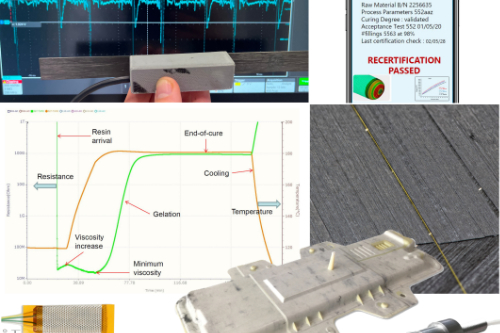Latest Aerospace Articles
VIEW ALLSpirit confirms sale of Fiber Materials Inc. business
Tex-Tech Industries, provider of high-temperature, high-performance specialty material and coatings, has completed the transaction for FMI.
Read MoreXenia collaborates with Politecnico di Milano team on competitive composite drone production
Xenia’s supply of reinforced 3D printing materials to the university’s student aerospace association, Fly Mi - Euroavia Milano, contributed to the team’s ability to meet the project’s demanding performance standards.
Read MoreFunctionalizing surfaces for sustainability
Riblets reduce drag, fuel consumption, CO2 emissions and noise while boosting power output, flow rates, speed and efficiency.
WatchDevelopment of a composite liquid hydrogen tank for commercial aircraft
Netherlands consortium advances cryogenic composites testing, tank designs and manufacturing including AFP, hybrid winding, welding of tank components and integrated SHM and H2 sensors for demonstrators in 2025.
WatchDaher inaugurates third technology center, Fly’in
Adding to its logistics and composite aerostructures facilities, Fly’in is equipped to advance Daher’s aerospace activities while fostering the emergence of eco-friendly technologies.
Read MoreAAMMC aerospace tech hub earns $50 million in funding
Federal funding, as well as industry and private commitments will establish a test bed for aerospace composite materials in the Pacific Northwest with industry partners like Boeing, NASA, Collins Aerospace, Toray, Syensqo and more.
Read MoreKnowledge Centers

Discover the types of sensors being used in composites, the physics on which they�re based, their installation, promised benefits and challenges, as well as the potential they offer for even further developments in smart structures.
LEARN MORELatest Aerospace News And Updates
Airbus reports 766 commercial aircraft deliveries in 2024
Full-year 2024 look demonstrates continued momentum for Airbus’ widebody orderbook, complementing its position in the single-aisle market.
Read MoreSiemens software chosen for JetZero BWB aircraft concept, launches Xcelerator updates
Aviation startup will use the Xcelerator platform to achieve its aircraft vision. Other Siemens collaborations deliver software additions to deliver, democratize industrial AI for small companies, startups.
Read MoreLeonardo unveils Proteus uncrewed rotorcraft demonstrator design
In the development of this fast-moving program, Leonardo is using a digital twin for synthetic development, more than 40 composite components and the use of AI in its control software.
Read MoreGKN opens $55 million aeroengine repair facility in North America
Enhanced support is now available for next-gen engine components and legacy systems, including GE LEAP and Pratt & Whitney Geared Turbofan models.
Read MoreCollier Aerospace HyperX optimizes X-59 composite nose cone
Swift Engineering relied on the CAE software’s structural sizing, analysis and test validation capabilities to deliver flight hardware for NASA’s supersonic QueSST aircraft early, under budget and with 25% weight savings.
Read MoreVirgin Galactic, ENAC to conduct spaceport feasibility study
Agreement with Italy’s civil aviation authority to determine the conditions for suborbital operations from the Grottaglie Spaceport, inspired by Virgin’s model in the U.S. with the composites-intensive VSS Unity.
Read MoreFeatured Posts
Carbon fiber/flax landing gear achieves 54% weight reduction via tailored layup optimization
Fuko’s Biogear showcases how strategic composite material distribution and natural fiber damping properties can lightweight and enhance critical aerospace structure performance.
Read MoreSchrödinger advances materials informatics for faster development of next-gen composites
Cutting time to market by multiple orders of magnitude, machine learning and physics-based approaches are combined to open new possibilities for innovations in biomaterials, fire-resistant composites, space applications, hydrogen tanks and more.
Read MoreBraided thermoplastic composite H2 tanks with co-consolidated molded boss areas to fit EV battery space
BRYSON project demonstrates possible designs, automated manufacturing and low permeability concepts, including EVOH liner and novel PPA matrix.
Read MoreComposites business growth through diversification, innovation
San Diego-based 2024 Top Shops qualifier Rock West Composites gives an overview of its relentless commitment to improvement, including its composite capabilities and its role as a trusted player in the space market.
Read MoreNatilus challenges the Boeing-Airbus duopoly
CW interviews CEO Aleksey Matyushev about composites, certification and the airlines’ needs for increased narrowbody production and decarbonization that aren’t being met.
Read MoreVIDEO: High-rate composites production for aerospace
Westlake Epoxy’s process on display at CAMX 2024 reduces cycle time from hours to just 15 minutes.
WatchFAQ: Aerospace
How are composites used in aerospace structures?
Since the 1950s*, composites have been growing in use in commercial and defense aircraft, ranging from struts and tail components, to wing skins and fuselages, to engine components and propeller blades.
One of the largest challenges to adoption of composites by the aerospace industry is stringent standards especially for safety critical structures, necessitating time- and labor-intensive processes to qualify new materials for use on passenger aircraft.
Qualified and well-tested autoclave-cured carbon fiber and thermoset-based prepregs are most often used for many structures, though other materials and formats, including thermoplastic tapes, are also in development or use.
Source: The FAA: Keeping up with aerocomposites evolution
*In the 1950s, Boeing began using fiberglass in its 707 passenger jets, and at the time the material made up about 2% of the overall aircraft by weight. Since then, Boeing, Airbus and other aircraft manufacturers have continued to increase this percentage with successive aircraft models. Today’s twin-aisle commercial aircraft such as the Boeing 787, first launched in 2009, and the Airbus A350 comprise approximately 50% composites by weight, largely carbon fiber-reinforced polymer (CFRP).
How are composites used in space structures?
At the time the Apollo capsule, which landed on the moon in 1969, was built by NASA, composites industry was still in its infancy and the materials were not yet in widespread use, though the Apollo capsule used early composite technology in the form of an ablative heat shield made from Avcoat, an epoxy novolac resin with silica fibers in a fiberglass-phenolic honeycomb matrix. A fiberglass honeycomb was bonded to the primary structure and the paste-like material was injected into each cell individually.
Since Apollo, advanced composites have evolved by leaps and bounds, and have played a significant role in space programs with use in launch vehicles, the space shuttle, satellites, space telescopes and the International Space Station.
Source: Composites in the race to space








































